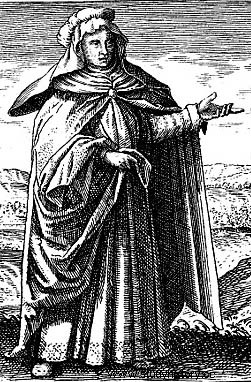Alchemist of the Hellenistic period, Mary the Jewess (also called Maria Hebraea, or Miriam Prophetissa) is considered one of the pioneers of alchemy; she is credited with the invention of several instruments and techniques, including giving her name to the bain-marie.
Hellenistic period
 What we know about the existence of "Mary the Jewess" we got mainly from the alchemist Greek native of Egypt Zosimus of Panopolis, who lived in Alexandria around the year 300, in the middle of the Hellenistic period. In his important work, which has come down to us in fragments, Zosimus cites the earlier work of alchemists and describes in particular the techniques and tools they used.
What we know about the existence of "Mary the Jewess" we got mainly from the alchemist Greek native of Egypt Zosimus of Panopolis, who lived in Alexandria around the year 300, in the middle of the Hellenistic period. In his important work, which has come down to us in fragments, Zosimus cites the earlier work of alchemists and describes in particular the techniques and tools they used.
Among other names, Zosimus evokes a Mary, whom he sometimes calls "Mary the Divine" and whom he classifies among the "ancients", therefore prior to the year 300. Other writings mention it later. The works of Bishop Epiphanius of Salamis (4th century) record a vision she would have had of Jesus, which places her after the advent of Christianity, but others like the Byzantine chronicler George Syncellus (8th century) place it before our era. She is also sometimes called "Sister of Moses".
In any case, Mary probably lived in Egypt before the 4th century, during the Hellenistic period and at the height of the rise of Western alchemy.
The bain-marie
Zosimus cites a work attributed to Mary the Jewess, On the stoves and instruments ( Peri kamino kai organon) , which describes tools and instruments of metal, glass and clay, used for cooking or distillation. The most famous device attributed to him is the water bath, a method of heating a substance by placing it in a container filled with hot water. Perhaps used earlier in Greek medicine, the bain-marie remained attributed to Mary the Jewess after whom it is named.
Other tools are attributed to Mary and described by Zosimus:the tribikos , a copper still with three receiving vessels, and the k erotakis, a still in a vacuum allowing alchemists to subject metals to the action of different vapours.
Maria's axiom
Mary the Jewess left a lasting mark on the history of alchemy and many of her successors quoted her and encouraged the spread of her work. In these texts, quotations and principles of alchemy are attributed to him:
Unite the masculine and the feminine, and you will get what you want.
The following principle is known as Mary's Axiom:
One becomes two, two becomes three, and from the third is born one as a fourth.
In the 10th century, Mary the Jewess is cited by the scholar Ibn al-Nadim as one of the 52 most famous alchemists. The German alchemist Michael Maier considers her to be one of the four women capable of producing the philosopher's stone.
